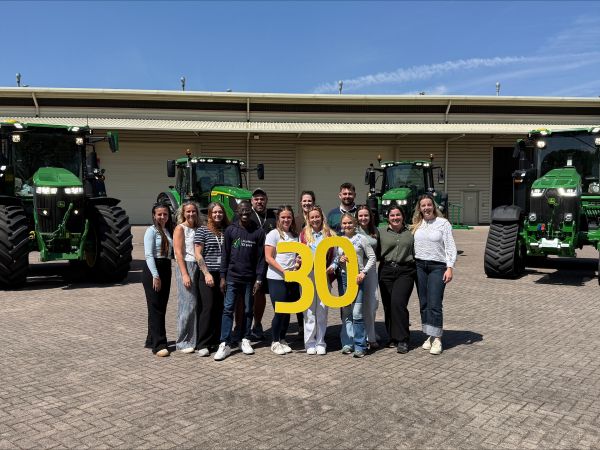
How useful is AI in agri communications and PR?
After recently delivering a Meat Business Women masterclass on AI, Rebecca Morgan, our AI taskforce lead, shares her insights.
How useful is AI in agri communications and PR?
Whether we're ready or not, AI is already transforming our industry and as communications professionals, embracing AI is no longer just advantageous but essential for staying ahead.
With great power, however, comes great responsibility, so how can we get the most out of AI while mitigating some of the risks that cause us to lay awake at night?
Will AI replace comms roles?
When Pinstone first began exploring AI at the start of 2023, a big red flag was whether it would replace us. After several years of utilising AI, I can confirm that the answer at this point in time is a firm no.
I would, however, add a caveat – if you don’t know how to effectively use AI in comms, you could be vulnerable.
While AI can handle much of the grunt work, we have found that people are very much needed to add the magic. Emotional intelligence, relationship building, and original creative thinking remain uniquely human strengths that are all critical to effective communications.
So while AI might handle data analysis and support with content generation, you're still the one building relationships with journalists, understanding nuanced brand messaging, and providing the critical thinking that transforms information into compelling narratives that will actually land.
This is particularly true for anyone communicating within farming, food or the environment – highly technical sectors with complex messages that rely on a deep and sensitive understanding of industry issues and the target audience’s needs.
AI as your communications co-pilot
AI excels at time-saving tasks that would otherwise consume precious hours of your day.
Think content ideation to get you going when you're facing the dreaded blank page, analysing results from across multiple platforms, repurposing original content for different channels, and summarising lengthy reports or data-heavy documents.
However, it's vital to know where to draw the line. AI can generate ideas at lightning speed, but our role as PR professionals remains essential in shaping content that will truly resonate with our target audience.
We bring context, nuance, emotional intelligence and accuracy that AI simply cannot replicate.
When it comes to brand reputation, AI "hallucination" is something to particularly fear. This is when AI produces very plausible-sounding facts, statements, or narratives that may not be true – if it doesn’t know the answer, sometimes it will just make it up!
This makes it crucial to check all AI-generated content carefully for accuracy, relevance, and tone – especially when communicating within specialist sectors like agriculture.
Copying and pasting AI generated content without proper evaluation risks a highly embarrassing faux pas, and more seriously, reputational damage.
Ultimately, AI does offer efficiencies, and this allows us to focus our time in the areas where we can add most value – the end result being better outcomes for our clients.
AI tools
The potential tech stack for AI tools is now huge, and quite frankly overwhelming. At Pinstone, our approach has been to assess our workflow, identify gaps or labour-intensive areas, and then find an AI tool to help.
In terms of a foundation AI tool, we’ve trialled a few different ones. Here’s a quick summary of our practical experience of some of the main ones.
![]() ChatGPT – probably remains the best all-rounder. Offers versatility and strong conversational abilities, making it excellent for brainstorming and content drafts. However, it can sometimes produce verbose responses and be prone to hallucination.
ChatGPT – probably remains the best all-rounder. Offers versatility and strong conversational abilities, making it excellent for brainstorming and content drafts. However, it can sometimes produce verbose responses and be prone to hallucination.
![]() Microsoft Copilot – integrates seamlessly with Office applications, making it ideal for teams already embedded in the Microsoft ecosystem. Its strength lies in productivity tasks, but we have found it less creative than either ChatGPT or Claude.
Microsoft Copilot – integrates seamlessly with Office applications, making it ideal for teams already embedded in the Microsoft ecosystem. Its strength lies in productivity tasks, but we have found it less creative than either ChatGPT or Claude.
![]() Claude – excels in nuanced writing tasks and tends to produce more natural, human-like responses. It's particularly strong at understanding context and maintaining consistent tone.
Claude – excels in nuanced writing tasks and tends to produce more natural, human-like responses. It's particularly strong at understanding context and maintaining consistent tone.
![]() Otter – excels at real-time transcription and meeting summaries, making it very helpful for capturing client calls, interviews, and brainstorming sessions. It can identify different speakers and generate actionable summaries, though accuracy can vary with accents or technical terminology common in agricultural sectors.
Otter – excels at real-time transcription and meeting summaries, making it very helpful for capturing client calls, interviews, and brainstorming sessions. It can identify different speakers and generate actionable summaries, though accuracy can vary with accents or technical terminology common in agricultural sectors.
The do's and don'ts of AI use in comms
Providing you have appropriate guardrails in place, there is no doubt that AI is an incredibly helpful addition to our toolkit. But there are some definite dos and don’ts.
The don'ts –
- There are telltale AI giveaways that shout automated content - be vigilant and don't miss these.
- Watch for overuse of emojis, excessive dashes, formulaic structures, repetitive vocabulary (underscores, foster, amidst – the list goes on), unnecessary bold or italic text, and American spellings in UK content.
The do's –
- Use AI as a starting point, not a finished piece.
- Always fact-check outputs, maintain your brand’s tone of voice, and add human insight that provides genuine value to your audience.
Data and privacy concerns –
- Never input confidential client information, proprietary data, or sensitive business details into AI tools.
- Most AI platforms use inputs to improve their systems, potentially compromising confidentiality.
Looking forward
The genie is well and truly out of the bottle and AI isn't going anywhere.
In fact, it's becoming increasingly more sophisticated and integrated into our daily workflows, so it’s crucial we learn to leverage AI's strengths strategically and responsibly.
The human story behind the data remains irreplaceable.
Use AI to handle the heavy lifting but never lose sight of what makes you uniquely valuable as a communications professional.

Want to read more about AI in agri-communications? Have a look at our previous post AI - friend or foe.
More recent insights

Why hire a PR agency when you could employ someone?

Cultivating journalism skills at John Deere with the Guild of Agricultural Journalists

The power of visual storytelling in the fight for family farms

Sign up to our newsletter
Keep your finger on the pulse.
